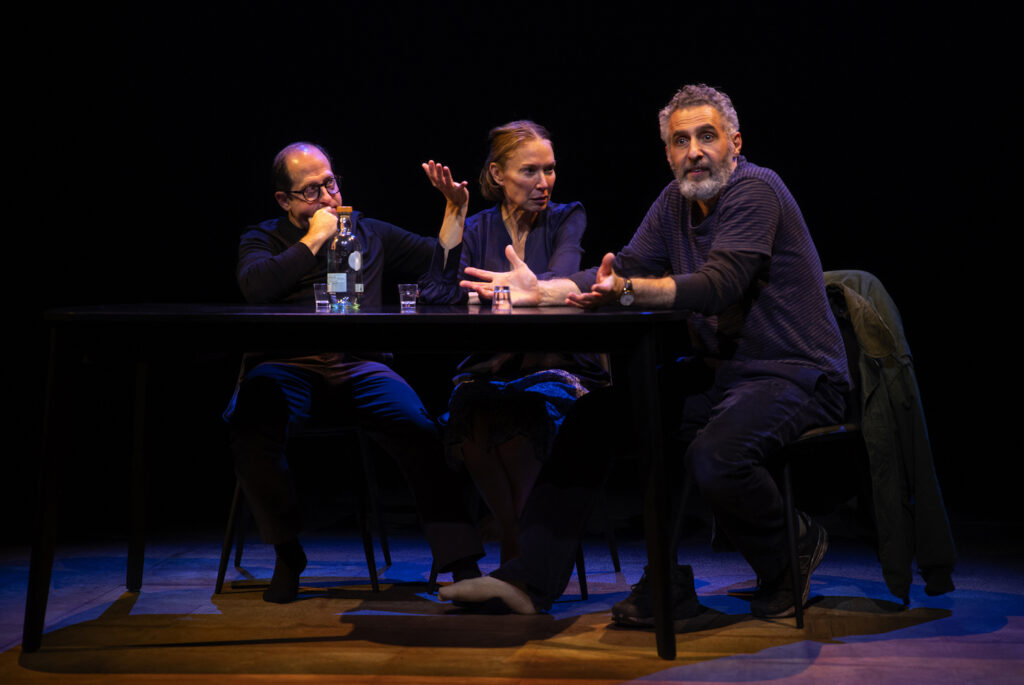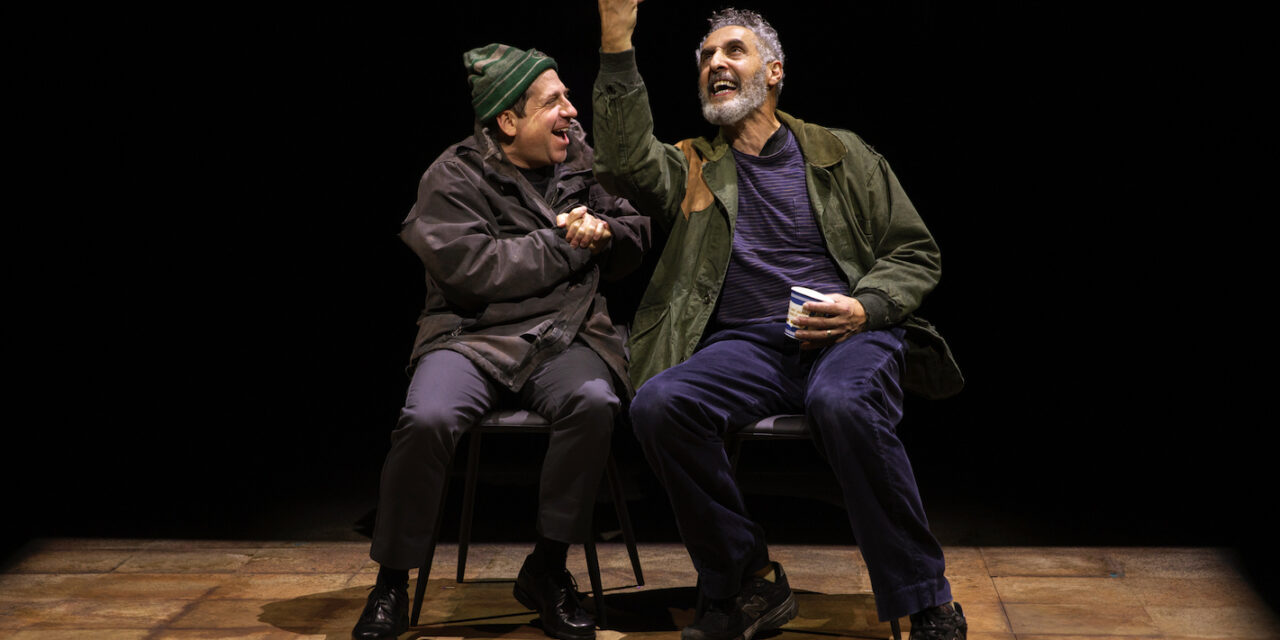By Samuel L. Leiter . . .
Philip Roth, the prolific novelist who died in 2018 at 85, saw eight of his books adapted for movies and TV, but very few for the stage. However, John Turturro has now co-adapted (with Ariel Levy) and stars in the New Group’s engrossing but imperfect Off-Broadway production of the writer’s National Book Award-winning 1995 novel, Sabbath’s Theater. Turturro, a friend of Roth’s, was once involved in a one-man adaptation of Portnoy’s Complaint; unfortunately, it got no further than readings. I also recall a Broadway evening in the 70s of three one-acts based on Roth short stories, but nothing else comes immediately to mind.
For all its felicities, Sabbath’s Theater reveals that Roth’s richly literary writing, while verbally and intellectually interesting, not to mention funny, struggles to spring to full dramatic life when staged, even with the finest actors. Director Jo Bonney approaches the material with physical simplicity on a bare, black stage designed by Arnulfo Maldonado using a minimum of scenic props. It’s efficiently lit by Jeff Croiter, backed by Alex Basco Koch’s scene-setting projections, and incorporates Erik Sanko’s shadow puppet designs. But the sense of a well-staged “reading” without scripts is never far from mind.

As typical of Roth, Sabbath’s Theater mixes Rothian autobiographical elements with fiction, much of it dealing with sexual preoccupations, some of them hilarious, told largely through the narration of the title character, Mickey Sabbath. He switches among first person direct address, referring to himself in the third person, and engaging in dialogue with others. The multiple other roles are divvied up between the marvelous Elizabeth Marvel and the versatile Jason Kravits.
64-year-old Mickey Sabbath is a bearded, shabby, emotionally fiery, bitingly sardonic, deeply conflicted, and everlastingly lustful man who had to give up his career as a puppeteer and Off-Off director because of arthritis. Brilliant but broke, he’s getting older as nearly everyone who once meant something to him passes away. Set in 1994, and essentially plotless, Sabbath’s Theater is faithful to the original, being a nonlinear character study of Mickey’s relationships with the women he’s known and the boundary-breaking sexual drives that define him as a degenerate; that, by the way, is a concept he fully embraces as he ruminates on life, death, sex, love, and hate. He even exclaims, “My failure is not having gone further!”
Obsessed with death and the loss of the loved ones whose ghostly presences he conjures up, in situations that move backward and forward in time, he seems eternally traumatized by the death of his beloved brother, Morty, who died during the war in 1944. The most moving scene shows him at the New Jersey seaside, contemplating drowning himself, as—his brother’s red, white, and blue yarmulke on his head—he ponders a box of Morty’s mementos, the source of the flag mentioned earlier. Suicide is on his mind at the same time as he’s driven by the life force implicit in his sexual impulses, no matter how over the top. In the most extreme scene, he’s moved by her memory to masturbate at the graveside of his late lover, who, even in death, arouses him.


Among Marvel’s roles are Mickey’s wives, the one who disappeared one day and the alcoholic who considered doing to her spouse what Lorena Bobbitt did to hers; his sex-crazy Croatian mistress, who died of cancer; his old friend’s libidinous periodontist wife, toward whom Mickey makes advances; and his mother, who zoned out after her other son died. Kravits’s roles show him chiefly as the old friend (whose daughter’s underwear Mickey pilfers), a bum whose wife left him to marry a woman, and a 100-year-old cousin at whose house he discovers Morty’s things.
Unavoidably, this approach, with characters differentiated largely by accents and behavioral tics, sometimes gives certain scenes a sketch comedy feel. On the other hand, those situations when Mickey argues with his mother and wife pop out with all the savagery we can imagine from published accounts of Roth’s private life. And many will appreciate the nostalgic feelings—tinted by Yiddishkeit—evoked by Mickey’s reminiscences with cousin Fish.
The book is considered Roth’s filthiest, and, while it contains decidedly naughty material, there’s not much here that hasn’t already been heard on New York stages. Thomas Bradshaw anyone? One scene, for example—spoiler alert—is a pleasurable recounting of the joys of being peed on. And, it might as well be said up front, we also get a scene—unnecessary, IMHO—of full frontal nudity presented by the uncompromising star, otherwise draped in an American flag.


The essential problem with Sabbath’s Theater is that, despite its emotional underpinnings, its effect in performance is largely cerebral. Dramatic action takes a back seat to rambling, if volatile, contemplation. The always compelling Turturro, blending rage, sarcasm, and despair, brings a Zorba-like energy to Mickey, but the necessity of telling a story while acting in it forces him to comment on his character rather than live it. This is true as well of his costars who, for all their insights and warmth, seem one step removed from living their roles, being more akin to the ghosts in Mickey’s memory than flesh and blood creatures of the here and now. Feelings are spoken of but, apart from a few scenes, most notably the one with Morty’s effects, insufficiently evoked.
The ad for the audiobook of Sabbath’s Theater, read by John Turturro, says it would take 18 hours and 20 minutes to listen to it. It would cost a bit more, of course, but, travel time aside, you can get the job done in an hour and a half by visiting the Linney Courtyard Theatre. And, if you’re curious, you’ll also discover why the Roman Catholic Turturro is suitable for casting as a Jewish man.
Sabbath’s Theater. Through December 3 at the Pershing Center Signature Theatre/Linney Courtyard Theatre (480 West 42nd Street, between Ninth and Tenth Avenues). One hour, 40 minutes—no intermission. www.thenewgroup.org
Photos: Monique Carboni


















